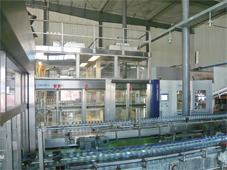 A very special kind of water The name for the new mineral water from the glaciers in the "Roof of the World" was quickly found: "5100", which is the spring抯 elevation in meters. Tibet Glacier has placed 5100 in the ultra-high-priced range: the target group can purchase the 500ml bottle in the supermarkets for an average of eight renminbi, the equivalent of 80 eurocents. This is about eight times as high as the prices for normal consumer mineral water. "There are huge differences between individual waters," said Wallace Yu, president of Mineral Water Resources Ltd. in Hong Kong by way of explanation. "That抯 something more and more consumers are going to take on board. There抯 good water and there抯 bad water. The water we get from the Nianqing Tanggula mountains, about one day抯 drive away from the Himalayas, is without a doubt among the best in the world."
A very special kind of water The name for the new mineral water from the glaciers in the "Roof of the World" was quickly found: "5100", which is the spring抯 elevation in meters. Tibet Glacier has placed 5100 in the ultra-high-priced range: the target group can purchase the 500ml bottle in the supermarkets for an average of eight renminbi, the equivalent of 80 eurocents. This is about eight times as high as the prices for normal consumer mineral water. "There are huge differences between individual waters," said Wallace Yu, president of Mineral Water Resources Ltd. in Hong Kong by way of explanation. "That抯 something more and more consumers are going to take on board. There抯 good water and there抯 bad water. The water we get from the Nianqing Tanggula mountains, about one day抯 drive away from the Himalayas, is without a doubt among the best in the world." Water from the glaciers in the 慠oof of the World?is bottled at a challenging elevation
The Nianqing Tanggula range, with its snow-covered peaks and glaciers, offers a well-nigh infinite supply of water. The region is also home to one of Buddhism抯 three sacred lakes, the "Heavenly Lake" of Namtso. The Qinghai-Tibet plateau is renowned as one of mankind抯 few remaining totally unpolluted regions. The spring used here is very productive, capable of yielding up to 3,000 cubic meters of water a day, and is rich in valuable minerals and microelements. Only about a fifth of the production output goes to the supermarkets. "In supermarkets, all we want to do is get ourselves better-known, show that this water actually exists," explains Yu. Most of the water is sold in restaurants, hotels, golf clubs and nightclubs ?to a discerning, higherearning clientele. Elegant square bottle An elegant bottle design was essential for this upmarket product positioning, and Tibet Glacier went for a classical square shape, one of striking visual elegance, but also not without its problems in terms of transport handling on the line. The company turned to PET design experts at packaging giant Krones, who provided the finishing technical touches, explains Yu. This bottle has been designed in sizes of 330ml, 500ml, 1.0L and 1.5L from preforms, produced in-house, which weigh 18g/330ml, 23.5g/500ml, 36.8g/1.0L and 47.6g/1.5L. So far the lightweighting issue has been of relatively minor importance for Tibet Glacier. "The stronger the bottles, the safer they are in transit, and the more comfortabLunarcharge Premium
 iConnectHub
iConnectHub
 Login/Register
Login/Register Supplier Login
Supplier Login



























